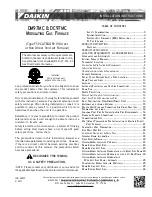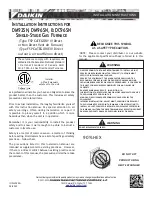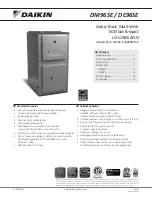
58SP0A/58SP1A: Installation, Start–Up, Operating and Service and Maintenance Instructions
Manufacturer reserves the right to change, at any time, specifications and designs without notice and without obligations.
39
(3.) Work cable in and out of cell 3 or 4 times to obtain
sufficient cleaning. DO NOT pull cable with great force.
Reverse drill and gradually work cable out.
(4.) Insert brush end of cable in burner inlet opening of cell, and
proceed to clean 2 lower passes of cell in same manner as
upper pass.
(5.) Repeat foregoing procedures until each cell in furnace has
been cleaned.
(6.) Using vacuum cleaner, remove residue from each cell.
(7.) Using vacuum cleaner with soft brush attachment, clean
burner assembly.
(8.) Clean flame sensor with fine steel wool.
(9.) Reinstall burner assembly. Center burners in cell openings.
10. Remove old sealant from cell panel and collector box flange.
11. Spray releasing agent on the heat exchanger cell panel where
collector box assembly contacts cell panel.
NOTE:
A releasing agent such as cooking spray or equivalent (must not
contain corn or canola oil, aromatic or halogenated hydrocarbons or
inadequate seal may occur) and RTV sealant (G.E. 162, 6702, or
Dow-Corning 738) are needed before starting installation. DO NOT
substitute any other type of RTV sealant. G.E. 162 (P771-9003) is
available through RCD in 3-oz tubes.
12. Apply new sealant to flange of collector box and attach to cell panel
using existing screws, making sure all screws are secure.
13. Reconnect wires to the following components (Use connection
diagram on wiring label, if wires were not marked for reconnection
locations.):
a. Draft safeguard switch.
b. Inducer motor.
c. Pressure switches.
d. Limit overtemperature switch.
e. Gas valve.
f. Hot surface igniter.
g. Flame-sensing electrode.
h. Flame rollout switches.
14. Reinstall internal vent pipe, if applicable.
15. Reinstall vent connector on furnace vent elbow. Securely fasten
vent connector to vent elbow with 2 field-supplied,
corrosion-resistant, sheet metal screws located 180
_
apart.
16. Replace blower access door only if it was removed.
17. Set thermostat above room temperature and check furnace for
proper operation.
18. Verify blower airflow and speed changes between heating and
cooling.
19. Check for gas leaks.
SEQUENCE OF OPERATION
NOTE:
Furnace control must be grounded for proper operation or
control will lock out. Control is grounded through green/yellow wire
routed to gas valve and manifold bracket screw. Using the schematic
diagram, follow the sequence of operation through the different modes.
Read and follow the wiring diagram very carefully.
NOTE:
If a power interruption occurs during a call for heat (W), the
control will start a 90-sec blower-only ON period two seconds after
power is restored, if the thermostat is still calling for gas heating. The
amber LED light will flash code 12 during the 90-sec period, after which
the LED will be ON continuous, as long as no faults are detected. After
the 90-sec period, the furnace will respond to the thermostat normally.
The blower door must be installed for power to be conducted through the
blower door interlock switch ILK to the furnace control CPU,
transformer TRAN, inducer motor IDM, blower motor BLWM,
hot-surface igniter HSI, and gas valve GV.
1.
Heating
The wall thermostat “calls for heat,” closing the R-to-W circuit.
The furnace control performs a self-check, verifies the pressure
switch contacts PRS are open, and starts the inducer motor IDM.
a.
Inducer Prepurge Period
- As the inducer motor IDM comes up
to speed, the pressure switch contacts PRS close, 24 VAC power
is supplied for a field installed humidifier at the HUM terminal
and the control begins a 15-sec prepurge period.
b.
Igniter Warm-Up
- At the end of the prepurge period, the
Hot-Surface igniter HSI is energized for a 17-second igniter
warm-up period.
c.
Trial-for-Ignition Sequence
- When the igniter warm-up period
is completed, the main gas valve relay contacts GVR close to
energize the gas valve GV, the gas valve opens, The gas valve
GV permits gas flow to the burners where it is ignited by the
HSI. Five seconds after the GVR closes, a 2-second flame
proving period begins. The HSI igniter will remain energized
until the flame is sensed or until the 2-second flame proving
period begins.
d.
Flame-Proving
- When the burner flame is proved at the
flame-proving sensor electrode FSE, the furnace control CPU
begins the blower-ON delay period and continues to hold the gas
valve GV open. If the burner flame is not proved within two
seconds, the control CPU will close the gas valve GV, and the
control CPU will repeat the ignition sequence for up to three
more Trials-For-Ignition before going to Ignition-Lockout.
Lockout will be reset
automatically after three hours or by
momentarily interrupting 115 vac power to the furnace, or by
interrupting 24 vac power at SEC1 or SEC2 to the furnace
control CPU (not at W, G, R, etc.) If flame is proved when flame
should not be present, the furnace control CPU will lock out of
Gas-Heating mode and operate the inducer motor IDM until
flame is no longer proved.
e.
Blower-On Delay
- If the burner flame is proven, the blower
motor is energized on HEAT speed 25 sec after the gas valve GV
is energized.
Simultaneously, the electronic air cleaner terminal EAC-1 is
energized and remains energized as long as the blower motor
BLWM is energized.
f.
Heat-Off Delay
- When the thermostat is satisfied, the R-to-W
circuit is opened, de-energizing the gas valve GV, stopping gas
flow to the burners, and de-energizing the 24-v humidifier
terminal 24VAC HUM. The inducer motor IDM will remain
energized for a 5-second post-purge period. Then turn off the
inducer motor. The blower motor BLWM and air cleaner
terminal EAC 1 will remain energized for 90, 120, 150, or 180
seconds (depending on the HEAT-OFF delay selection). The
furnace control CPU is factory-set for a 120-second Heat-Off
Delay.
2.
Cooling mode
The thermostat “calls for cooling”.
WARNING
!
FIRE OR EXPLOSION HAZARD
Failure to follow this warning could result in personal injury, death,
and/or property damage.
Never purge a gas line into a combustion chamber. Never test for gas
leaks with an open flame. Use a commercially available soap solution
made specifically for the detection of leaks to check all connections. A
fire or explosion may result causing property damage, personal injury
or loss of life.






































